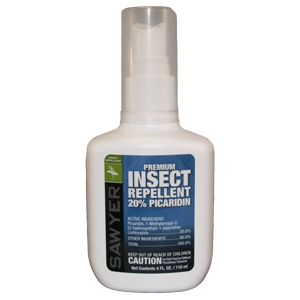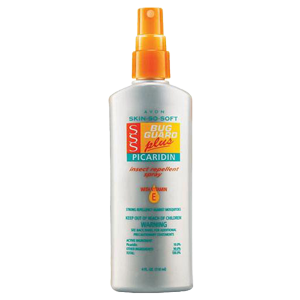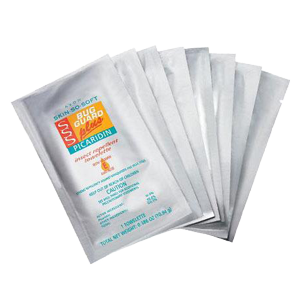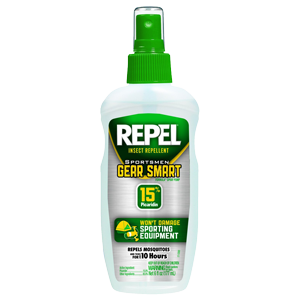Picaridin is an insect repelling active ingredient. It’s as effective as DEET at preventing insect bites. 20% picaridin products last up to 8 hours. The compound has a good toxicology profile. There’s only been one case of an allergic reaction.
History Cosmetic Properties Efficacy Mode of Action Toxicity
 |
 |
 |
 |
|
| Product Name | Sawyer Premium | Avon Skin-So-Soft | Avon Skin-So-Soft | Repel Sportsmen |
| Price | $9 | $10 | $8 | $10 |
| Size | 4 ounces | 4 ounces | 8 wipes | 6 ounces |
| Application | Pump Spray | Pump Spray | Soft Wipes | Pump Spray |
| Use On | Skin | Skin | Skin | Skin |
| Active Ingredients | Picaridin | Picaridin | Picaridin | Picaridin |
| A.I. Concentration | 20% | 10% | 10% | 15% |
| Duration | 6 – 10 hours | 3 – 5 hours | 3 – 5 hours | 4 – 7 hours |
| Product Label | ||||
| MSDS | ||||
| FleaScore | ||||
| Reviews |
- Prices are approximations based off of Amazon.com prices at the time of publishing.
- FleaScores are based off of product details (price, size, active ingredients, etc), as well as reviews aggregated from 3rd party sources.
What is Picaridin?
Picaridin is a synthetic insect repellent with a broad-spectrum of effectiveness. It prevents bites from numerous species of arthropods. Picaridin repellents are intended to be used by the general public, including adults and children.
Picaridin
Chemical Overview
| Chemical type | Pesticide – insect and acarid repellent |
| Chemical family | Piperidines |
| Manufacturer | LANXESS Corp. |
| Developed in | 1980s |
| Common names | Picaridin, icaridin, KBR 3023, propidine |
| Trade names | Bayrepel®, Saltidin® |
| INCI name | Hydroxyethyl isobutyl piperidine carboxylate |
| IUPAC name | 1-piperidinecarboxylic acid 2-(2-hydroxyethyl)-1-methylpropylester |
| CA name | sec-Butyl 2-(2-hydroxyethyl)piperidine-1-carboxylate |
| CAS No. | 119515-38-7 |
| Molecular formula | C12H23NO3 |
| Molecular mass | 229.3 g/mol |
| Physical state | Liquid |
| Odor | Nearly odorless |
| Color | Colorless |
| Molecular Structure |  |
History
A Need for New Repellents
DEET has been the standard insect repellent since becoming commercially available in 1957. However, there are increasing concerns related to health. DEET also has an unpleasant smell, a sticky feeling on skin, and it dissolves plastics. These traits have led to a demand for identifying new repellent molecules.
The Development of Picaridin
Picaridin was developed by Bayer AG in the 1980s. The repellent was first released under the trade name Bayrepel and sold under the brand Autan. In 2008, LANXESS and Saltigo split off from Bayer, and the trade name was changed Saltidin. It’s now owned by LANXESS Corporation.
Picaridin is part of a new generation of customized repellents. Molecular modeling techniques were used to map and construct three-dimensional molecules. Picaridin was designed under the hypothesis that the repellent effect was caused by interaction with an insect’s olfactory (smell) receptors. Known repellent compounds were altered at sites where interaction with receptors was anticipated. Through this process, more than 800 substances were synthesized and screened for efficacy, safety and compatibility with skin. Of these compounds, picaridin (KBR 3023) was the best candidate. It became the first synthetic repellent to go through modern efficacy and safety tests as part of the creation process.
Picaridin’s molecular structure is based on piperidine, a colorless organic compound with a peppery odor. It’s similar to the alkaloid in peppers (piperine) that creates the hot flavor. Picaridin is colorless, nearly odorless, non-greasy, and compatible with skin and plastic.
Consumer Availability
Picaridin has been in public use since 1998 in Australia and since 2001 in Europe. It was registered with the Environmental Protection Agency (EPA) in 2001. It first became available to US consumers in 2005 as a 7% solution called Cutter Advanced.
Picaridin has enjoyed significant market penetration since its inception. It’s now registered as an insect repelling active ingredient in over 50 countries. Today, picaridin is one of the most commonly used repellents in Europe and Australia. In the US, it’s available in sprays, aerosols, wet wipes, creams and lotions with concentrations of ranging from 5% to 20%.
Registration & Recommendations
In 2000, the World Health Organization (WHO) recommended picaridin as the repellent of choice for malaria prevention. In 2001, the EPA registered picaridin for commercial use, stating that it wasn’t significantly toxic. Insect repellents don’t require FDA approval. In 2005, the Centers for Disease Control (CDC) added picaridin to their list of recommended repellents for prevention of arthropod-borne illness.
Future Outlook
DEET has been the most widely used repellent for six decades. DEET is patent-free, cost-efficient, and has accumulated large amounts of safety and efficacy data. While picaridin has a good toxicological profile, it hasn’t been tested for decades with widespread commercial use. Picaridin is also generally more expensive than DEET.
Though DEET is popularly used, there are drawbacks related to its cosmetic properties. It also isn’t the best repellent against certain biting arthropods. These downsides allow for market penetration of alternative repellents. Picaridin, for example, is better tolerated on skin, has a lower toxicity and is comparable in efficacy.
Despite the demonstrated safety and effectiveness of DEET and picaridin, there’s growing reluctance to using these repellents. Synthetic products are being publicly perceived as having more health risks than those derived from botanical materials.
Cosmetic Properties
Picaridin has near-ideal cosmetic properties. It’s compatible with skin, mucous membranes and plastic materials. The compound is stable toward light, water, sweat and oxidation. It’s also biodegradable. Picaridin is odorless, doesn’t feel sticky or greasy, and skin irritation is uncommon. Those surveyed repeatedly report they prefer picaridin to DEET because of these properties.
User Acceptability
A questionnaire regarding insect repellent use was given to the Australian Defence Force. Of the soldiers surveyed, 80% won’t use the issued repellent (35% DEET gel) during their deployment because it feels unpleasant and dissolves plastics. In 2001, 150 soldiers were asked to compare the 35% DEET gel with a 19.2% picaridin pump spray. The soldiers used each repellent for a week, applying it twice a day. Picaridin was preferred by 94% of the soldiers. DEET caused significantly more reports of skin irritation (see Fig 1).
Fig 1 Percent of soldiers (y-axis) responding to the cosmetic properties of insect repellents (x-axis).
Other user acceptability questionnaires provide similar results. DEET is disliked due to its odor, skin reactions and uncomfortable oily, sticky feeling. Users also don’t like how DEET can damage synthetic clothes, leather, and plastics on eyeglass frames and watches.
Efficacy
Targeted Arthropods
Picaridin is a broad-spectrum repellent. It’s effective at repelling a variety of biting arthropods, including mosquitoes, ticks, flies, gnats, chiggers, midges, fleas and sand flies. Picaridin has also been demonstrated to repel ants and cockroaches.
Effective Duration
Picaridin starts repelling insects immediately after being applied to skin. It develops full performance within a few minutes. How long it lasts depends upon the targeted pest. Generally, 20% formulations of picaridin protect users from bites for 6 to 10 hours. 10% concentrations last around half as long (3 to 5 hours).
Fig 2 Minutes (y-axis) it takes mosquitoes to bite humans treated with different picaridin repellents (x-axis).
Picaridin lasts longer on skin than DEET or IR3535. The half-life estimates are 4.1, 2.9 and 2.9 hours, respectively. It persists on skin even in high temperatures and moist air. This is an important factor considering that moderate levels of physical activity (jogging, cycling) can reduce the protection time of DEET by 40%.
Against Mosquitoes
Numerous studies have compared the effectiveness of picaridin and DEET against mosquitoes. Results vary by species, but generally the efficacy of picaridin is comparable or superior to DEET in equal concentrations. Picaridin has also been demonstrated to be superior to IR3535 at repelling mosquitoes.
In one of these studies, picaridin, IR3535 and DEET were tested against mosquitoes in the Everglades National Park (see Fig 3). The average complete protection times were 5.4, 3.0 and 5.6 hours, respectively. Over six hours, mean repellency was 97.5%, 88.6% and 94.8%.
Fig 3 Percent mosquito repellency (y-axis) provided by different insect repellents across 6 hours (x-axis).
The most comprehensive study was done over the course of two years. Formulations of 10% and 20% picaridin and 20% DEET were tested against numerous species of mosquitoes (see Fig 4). Across five hours, their repellency was 95.36%, 98.36% and 98.6%, respectively. Their efficacy varied slightly depending on mosquito species.
Fig 4: Percent repellency (y-axis) of three repellents (x-axis) across 5 hours against numerous species of mosquitoes.
Against Ticks
Picaridin is effective at deterring ticks, demonstrated in studies on lone star ticks (Amblyomma americanum). 10% picaridin, 20% picaridin and 33% DEET all provide full protection from bites for over 12 hours. Sunscreen repellents slightly decrease efficacy.
Efficacy against the bont tick (Amblyomma hebraeum) isn’t as good. A lotion containing 20% picaridin stopped 85%, 56%, 55%, and 54% of tick attacks at 1, 2, 3 and 4 hours after application, respectively. A 20% DEET lotion repelled 85%, 84%, 68% and 71% of the ticks.
Against Biting Flies
Picaridin is effective at repelling biting flies, as demonstrated in studies against sand flies (P. duboscqi and P. papatasi) and black flies (Simulium venustum). Against the black fly, AI3-37220 (a piperidine repellent similar to picaridin) provided over 95% protection from bites for 6 hours, while DEET only offered 90% protection. Against sand flies, 10% and 20% formulations of picaridin performed better or equal to a 50% DEET lotion (see Fig 5).
Fig 5: Hours of protection (y-axis) provided by 4 picaridin repellents and 1 DEET repellent (x-axis) against sand flies.
Against Fleas
Picaridin is an effective repellent of cat fleas (Ctenocephalides felis). Both 20% picaridin and 20% DEET offer complete protection from flea bites for 9 hours.
Against Midges
Picaridin’s efficacy against the Scottish biting midge (Culicoides impunctatus) is mediocre. Its repellency was 84%, 78%, 65%, 67% and 60% at 0, 2, 4, 6 and 8 hours after the being applied to skin, respectively.
Against Kissing Bugs
Picaridin is a weak repellent of the kissing bug (Triatoma rubida).
Mode of Action
Insect repellents work through interactions with olfactory receptors (smell) and gustatory receptors (taste). However, the exact mechanism of action of picaridin and other repellents is currently unknown.
Olfactory Receptors
Picaridin and other repellents deter insects from a distance, indicating interaction with olfactory sensilla. Different repellent compounds have different chemical structures and affect different olfactory receptors (OR). They don’t have a common mode of action.
Insect repellents are agonists, activating ORs even in the absence of a host. They’re also antagonists which inhibit the ability of insects to detect nearby hosts. Lastly, repellents are synergistic, hyper-activating the receptors and causing confusion in host detection.
Picaridin doesn’t act upon the same receptors that are involved in host attraction. The repellent triggers its own chemosensory response in the antennae. The mode of action isn’t a masking or suppressing effect. Antagonistic effects are caused by receptor cells unrelated to host odors or pheromones that are counteracting the attraction response.
It’s believed that repellents work by overstimulating ORs in the presence of a host. When picaridin is presented with an attractant, a new, unique input is activated in the insect’s brain. This scrambled pattern differs greatly from the attractant. The insect can’t understand it. As a result, they can no longer detect the host.
Gustatory Receptors
Repellents also effect insect gustatory receptors. When insects are exposed to repellent compounds, a feeding deterrent response is triggered. This also works on insects in the larval stage.
Insecticidal Effect
Picaridin doesn’t have any insecticidal effect. However, DEET does. Picaridin also doesn’t affect flight take-off like some other repellent compounds. This provides further evidence that repellents do not behave as a single class of compounds with a common mode of action.
Oviposition Deterrent
In relatively low doses, DEET and piperidine repellents can deter insects from laying eggs. Mosquitoes won’t deposit eggs in areas where the compounds are present. The piperdine repellents are more effective and last longer in water than DEET.
Antimicrobial Properties
Multiple insect repellents, including picaridin, have antifungal and antibacterial properties. Picaridin has a stronger antibacterial effect than DEET, while DEET has stronger activity against yeast and fungi.
Toxicity
Picaridin has a good toxicology profile. The WHO has stated it’s a safe and effective insect repellent for human use. The EPA concluded that picaridin is not significantly toxic and can be safely used by adults and children. In 2000, picaridin was recommended as the insect repellent of choice by the World Health Organization due to its safety and cosmetic features.
Picaridin
Toxicity Data
| Acute Dermal Exposure | III | EPA Fact Sheet |
| Acute Oral Exposure | III | Picaridin MSDS |
| Acute Inhalation Exposure | IV | NPIC Fact Sheet |
| Primary Skin Irritation | IV | EPA Repellent Safety |
| Primary Eye Irritation | III | CDC Repellent Safety |
| Dermal Sensitizer | no | AAP Repellent Safety |
| Carcinogen | no | |
| Fish | II | |
| Aquatic Invertebrates | IV | |
| Birds | IV |
Reports of Adverse Reactions
Skin reactions to picaridin are rare. There’s only been one report of an adverse effect. In 2005, a man had an allergic reaction to the repellent. However, he was also sensitive to the emulsifier used in the aerosol spray.
Acute Toxicity
Picaridin has a low acute toxicity to mammals through all routes of exposure. It’s not irritating to skin and only slightly irritating to eyes. It’s practically non-toxic when inhaled and only slightly toxic when swallowed. Picaridin is not a skin sensitizer. No phototoxicity has been observed.
Use on Children
According to product manufacturers and the WHO, picaridin shouldn’t be used on children younger than 2 years old.
The EPA has determined that 7% to 20% picaridin repellents are safe to use by children. Still, some sources recommend using 10% concentrations. It’s also suggested to use lotions and not sprays. Sprays are more likely to contact sensitive areas of the face.
Mucous Membranes
Picaridin has good compatibility with mucous membranes (e.g. nostrils, lips, eyelids and ears). DEET, on the other hand, irritates mucous membranes, making facial application inadvisable.
Skin Absorption & Excretion
Picaridin is poorly absorbed through human skin, and that which gets absorbed is rapidly excreted. About 10% of the applied dose is absorbed through human skin over a 24 hour period. In an 8 hour period, less than 4% is absorbed. Over 94% of the absorbed dose gets excreted as metabolites through urine within the first 24 hours. The excretion half-life in humans is 8.2 hours at a low dose. Picaridin doesn’t accumulate in skin.
Carcinogenicity
Studies haven’t found any carcinogenic or genotoxic effects of picaridin when applied to skin.. In 1999, the EPA Health Effects Division’s Hazard Identification Assessment Review Committee (HIARC) determined that picaridin wasn’t likely to be a carcinogen by the dermal route, and found no evidence of endocrine disruption.
Reproductive Toxicity
Studies on reproductive toxicity were done with rats and rabbits. There weren’t any statistically significant effects for any reproductive parameters when picaridin was applied to skin. No developmental toxicity was observed at any dose level.
Neurotoxicity
There wasn’t any evidence of acute or chronic neurotoxicity when picaridin was administered to the skin of rats. It also doesn’t bioaccumlate.
Dogs & Cats
Limited information exists on picaridin’s adverse effects to domestic pets. There was one laboratory study with beagle dogs, and no adverse side effects were seen. There’s no data on toxicity to cats.
Environmental Toxicity
The EPA has stated that picaridin shouldn’t pose a risk to the environment through the proposed use. The WHO found picaridin’s acute toxicity is low for water fleas (aquatic invertebrate) and rainbow trout. The EPA determined it’s moderately toxic to rainbow trout, practically non-toxic to water fleas, and somewhat hinders the growth of green algae. It’s non-toxic to birds.



You must log in to post a comment. Log in now.